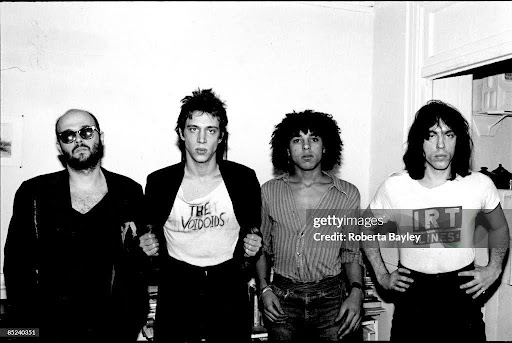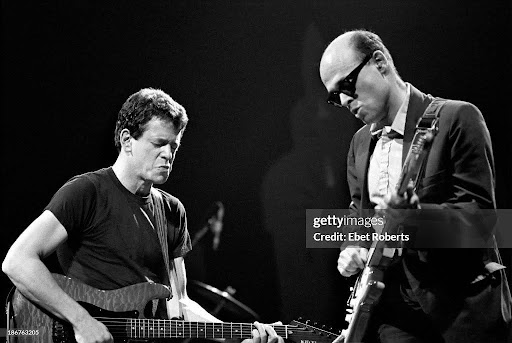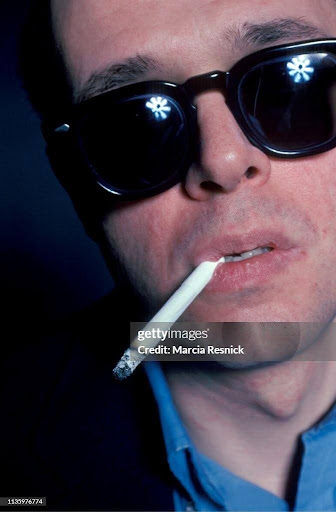
The Beastie Boys and Me
Published on Dec 10, 2025
The Doors and Me
Published on Dec 8, 2025
Hold the Line: a breakup story starring Toto
Published on Dec 3, 2025
Letter From the Publisher
Published on Nov 29, 2025
More Liner Notes…
Featured Essay: The Lost Record Collection of NY Punk Legend Robert Quine
by Nickolas Tsui

During the Pandemic, I was an essential worker and had to be on site. I worked up in a security dispatch center, which could get crazy at times, but during times things weren’t, I would look online for old blues records. One day, I came across a listing on eBay for Howlin’ Wolf’s self-titled album. Better known as the ‘Rocking Chair’ album, it was listed as an original pressing in very good condition ‘with some very light writing on back.’ As I looked at the photos, it was indeed a beautiful copy of the album. It was also quite expensive - $600! Had it not been for its previous owner writing his name on the back side above Howlin’ Wolf, it may have been a near perfect example and would have gone for much more.
At first, I was sad that one thing ‘ruined’ the album. It was common practice back in the day for the owner of a record to write their name on the front or back though – there was no streaming or Spotify, so if you brought the same record to a party, that was how you’d identify yours from someone else’s. Just before I closed out of the listing, I had a pause – something about that name. A beautiful, every-letter signature of a man named Robert Quine. It wasn’t a common name and I was quite sure I had come across it before. Then it hit me like a bolt of lightning – Robert Quine was originally listed in the original ‘100 Greatest Guitarists of All Time’ list by Rolling Stone magazine!
“I remember him as a reclusive, eccentric and very kind man who had ornery opinions about music and studied guitar styles with passion and an obstinate perfectionism. He was never interested in flash - just doing the right thing at the right time, at which he excelled. A real pop original.”
- Fred Frith

The wheels in my head were turning now. I quickly looked him up to jog my memory. Robert Wolfe Quine was a brilliant guitar player who had been an integral part of the New York/CBGB punk scene during its heyday. He went on to work with Tom Waits, Lou Reed, They Might Be Giants, Brian Eno, Michael Sweet, and Richard Hell and the Voidoids to name a few. But, despite being such a genius of the instrument, he passed away and remains unknown to most. Still, he went on to record and work with most of his musical idols and heroes in some capacity. He was also a massive fan of the Velvet Underground and recorded some of their sets which later became known as The Quine Tapes. I couldn’t really figure out why such a figure in punk would have a blues record though, so I dug deeper and discovered that prior to his involvement in that scene, he both loved and studied early rock and roll, blues, and jazz before taking what he learned how to play from those genres and injecting those sounds into the shape of punk. I also found out that he had a massive record collection and was regarded by many of his peers as a musical encyclopedia.
“Our friendship clicked and resolved itself around the following: a love of wandering round New York and eating in obscure oriental restaurants; a feeling for music that was ‘at the edge of music’; a conviction that Nabokov was the greatest writer of the twentieth century, and a shared sense of humor. For, despite Robert’s daunting appearance, he was actually very funny and as sweet and good-hearted a person as you could imagine. And paranoid too, I should mention, he lived in a flat on St. Mark’s Place which had more defenses on the door than The Bank of England. But then he did have a huge collection of beautiful electric guitars - a collection which, along with his records and books, left an increasingly narrow path between the Fort Knox door and what he laughingly described as ’the kitchen’ - an unused single-plate electric cooker sitting on a table.
I don’t think I ever visited Quine without him digging out some obscure doo-wop song or old jazz record and getting me to listen to a genius piece of guitar playing by some long-forgotten craftsman. He was a sort of archaeologist of popular music, deeply knowledgeable and with a phenomenal memory for detail.
In the Daily Telegraph obituary about Robert, the writer stated that Robert’s experience working on my Nerve Net album had stimulated his interest in Ambient Music. In fact, Quine was instrumental in the development of Ambient Music - during my stay in New York it was he who encouraged me in the unfamiliar new music I was doing there - which became On Land. Without his interest, I’m not sure I would have ever finished and released that record.”
- Brian Eno

In a matter of minutes, the Wolf record went from being a near perfect copy to imperfect, to priceless. I knew in my gut that the album I was looking at had to have been Robert’s own personal copy. I ended up buying it, but I would have to figure out a way to validate it beyond just an initial instinct. I did more and more research and when it rains it pours – the seller I bought the record from had an online store, and I discovered they also had a copy of Howlin’ Wolf’s Moanin’ in the Moonlight for $500. This listing made no mention of writing on the front or back covers, but when I scrolled down to the photos, there it was. Signed by Robert Quine in nearly the exact spot as the other album. This album also had tick marks next to certain songs, which I would assume were some of the choice cuts of guitar tracks.
“I knew Bob at Earlham College and then at Washington University, where he was studying law (1965-68). I remember spending hours with him listening to records, a memorable and profound experience for anyone privileged to have that opportunity. He was a blues/rock/jazz scholar -although not in the academic sense. His record collection was huge. I remember him saying how when he went home, he had to smuggle records in because his parents were concerned about the size of his collection and obsession with it. He recalled as a kid travelling in the South with his parents and being intrigued by the name of Howlin’ Wolf on a record, the rawness the name promised, and getting the record.”
- Ralph Engelman
I was in disbelief; these records were just floating out there for anyone smart or lucky enough to realize their true nature and importance. I doubt that the seller actually knew what he had, because there had been no mention of Robert Quine at all. I was also at war with myself. I had just dropped $600 on an album and this one would cost another $500 which I really didn’t have to spend on it. But, few things present themselves to you in life like this did. I showered, told myself ‘It’s only money, it comes back,’ bit my lip and clicked ‘commit to buy.’ That was it – those two records had cleaned me out! But I wasn’t done yet. Since there were two albums signed by Quine, I decided to look at every single listing in the store to see if there was anything else that might’ve come from his collection. I was correct on my hunch and there were 15 more albums, some the best-ever recorded, and if not, surely featured some of the greatest artists of all time! Luckily, none were as expensive as the ones I just bought, but it still took me several months of buying them piece by piece because of funding and not wanting to raise suspicion. The seller knew the records inside out and sold them as such, but he didn’t know the signature, and that was a huge X factor overlooked. I was able to get all of them except for one – John Lee Hooker’s Plays & Sings the Blues.
I had asked the seller, whose shop was in Baltimore, MD, how he came to get some of the albums. He replied that he got them from Rudi Blesh’s collection. I didn’t know who that was at first, but after looking him up, I discovered he was a prominent figure in the NY jazz scene – he was a well respected critic and teacher, he wrote They All Played Ragtime, hosted a jazz radio program called This Is Jazz, and promoted concerts. His writings were published by the San Francisco Chronicle and New York Herald. Both Quine and Blesh lived in New York during a three-year overlapping period as well, so the case did hold water. I also stumbled on an article written by Blesh’s grandson, Carl Hultberg, which basically described how he went to a jazz show with Rudi on Bleeker St., slipped out, and saw Howlin’ Wolf at another club nearby; how he was in trouble until he told his grandfather he’d just seen the Wolf play. I had so many questions I wanted to ask Carl, which could have led to some great findings, however, I discovered Carl had also passed away. Because of this, we’ll never know if the albums really did come from Blesh’s collection, and I personally don’t think they did, but the fact that there is that slim chance adds all the more mystery.
While I was in the process of acquiring the albums, tracing the history of them and Quine himself, I was also trying to figure out a way to authenticate them. That wasn’t so easy – after Quine passed away, there wasn’t much known about what happened to his things. His record collection basically disappeared and anyone who could really confirm anything had also passed away. I ended up talking to several people who knew Quine, and all were happy that I was researching his story and provided additional insight that helped along the way. Rick Kelly of Carmine St. Guitars, a shop Robert frequented often, confirmed that many of Quine’s guitars were sold through the store. His friend Jim confirmed that Quine’s books and records were procured by Michael Carlucci, who passed away. And through an interview on a radio station, I learned that almost, if not all of Quine’s remaining collection was sold off and scattered by Michael’s shop, Subterranean Records.
Apparently, of the “massive record collection floor to ceiling and the length of his apartment,” Quine only signed a fraction of the earliest albums he owned, and with no way of telling on the others if they were Quine’s, no one would ever know they might have one of his records in their own collection. I attempted to find more examples of Robert’s signature for comparison and to solidify my claim. I reached out to Brooke Delarco, Jody Harris, Barry Silverblatt, Richard Hell, James ‘The Hound’ Marshall, Doug Quine, and Ralph Engelman. Most were either bandmates, college friends, or relatives, and I asked each of them about Quine’s records and if they had any of his signatures or handwriting that I could look at. Silverblatt had some letters from Quine that he was nice enough to photocopy for me, Doug Quine was able to provide me with photos of the back sides of two checks Robert had endorsed, an early photo of Robert, and a blown-up copy of Robert’s Oath of Admission to the State of Missouri Supreme Court in 1969. Ralph Engelman provided me with a photo of a jazz album Quine gave him long ago and answered many of my questions. On the back was Quine’s signature just like the albums I had. I knew this was it!
There were more reasons authentication was tough: by the time Quine was signing signatures for fans, it was so degenerated from these early pre-fame examples I had. His signature would look like an R and a Q with a loop of some kind; not the every-letter examples I had. Also, as great a musician as he was, he wasn’t very well known in the mainstream. So, any of the reputable third-party authentication companies would have plenty of experience evaluating a signature of Bruce Springsteen, for example, but wouldn’t really have much to work with when it came to Quine. I sent photos of the records to Richard Hell who agreed they were authentic. Finally, I was able to bring the records to a memorabilia show that James Spence Authentication (JSA), a leading company, was at and spent the fees for on-site examination.
It took several weeks, but the letters of authenticity finally arrived and all but one album passed. The one that didn’t, Bo Diddley – Is a Gunslinger, was due to the fact he had printed his last name on the album and didn’t actually sign it. However, I still believe that the writing was done in Quine’s own hand, as he did rarely but occasionally print. The overall verdict? These are the actual records he spun at his blues radio show at Earlham College in Indiana, his apartment in St. Louis while he studied law at Washington University, and his pad at St. Marks Place while he drank martinis with Richard Hell. They’re some of the best records ever made and were used by Quine to help him learn how to play so that he, in turn, could go on to record on even more of the greatest albums ever made. These records are a tangible link to how music can transcend from one genre to the next; how one great record can directly influence another great record. Somehow, these records found me and I’m grateful that I was able to restore part of Robert Quine’s legacy to its original glory, even if it’s just a piece.
“At CBGB, the Voidoids’ incredible guitarist, Robert Quine, shredded his Fender over symbolist-inspired lyrics, making sounds never heard before or since.”
- Anthony Bourdain
Robert Wolfe Quine’s Collection 1957 - 1964:
Henry Thomas – Sings the Texas Blues (1962)
Memphis Slim – Chicago Blues (1960)
The Mississippi Blues 1927 – 1940 (1963)
Bo Diddley – Is a Gunslinger (1960)
Furry Lewis – His Voice and Guitar (1960)
Really! The Country Blues 1927 – 1933 (1962)
Howlin’ Wolf – Howlin’ Wolf (1962)
Howlin Wolf – Moanin’ in the Moonlight (1959)
Texas Blues: Vol. 1 Achoolie Gold Star (1963)
Jimmy Reed – Now Appearing (1960)
The Rural Blues (1960)
Henry Townsend – Tired of Bein Mistreated (1962)
Big Bill Broonzy And Washboard Sam (1962)
Little Richard – Here’s Little Richard (1957)
Kings of the Twelve String (1964)
John Lee Hooker – Travelin’ (1960)
John Lee Hooker – Plays & Sings the Blues (1961)*
*did not get
Nickolas Tsui is a lover of music and collector of memorabilia - vinyl, posters, and signatures. He loves to share his stories and adventures, go see live music, travel, and meet the musicians he admires. He has written for Howl Magazine, The UMass Lowell Connector Student Newspaper, and The Blues Audience Newsletter. Residing in Nashua, NH, he is currently writing his first book, The Steward of the Strings,’ about guitarists he’s met over the years. Besides collecting records, he is part of a group that meets once a month to spin them. When not enveloped by music and records, he enjoys reading, watching movies, trying new foods, a good whiskey, and shooting billiards.

